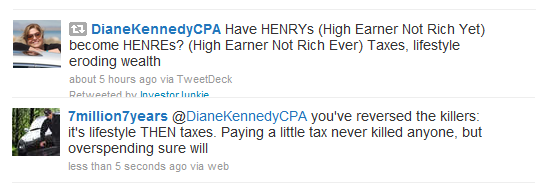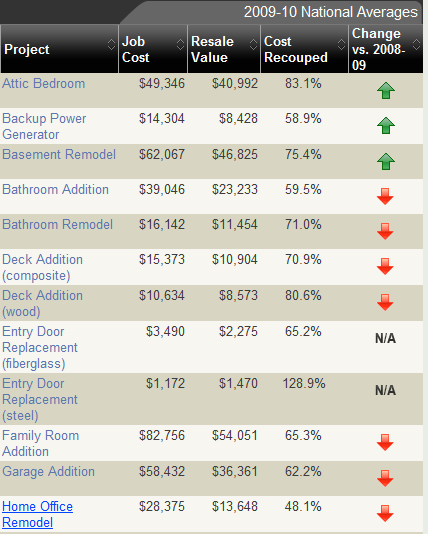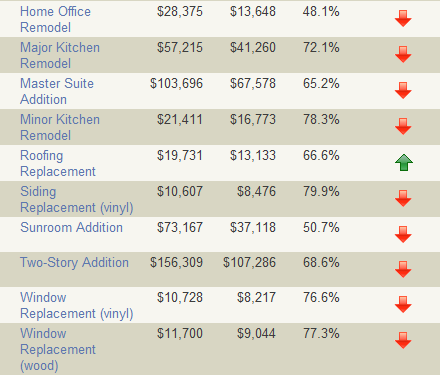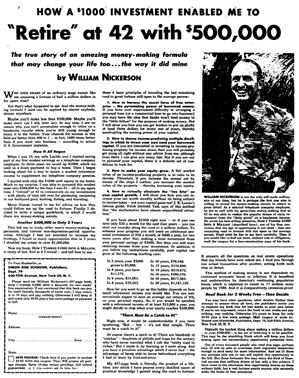
Actually, it’s not the problem with Henry, it’s the problem with HENRY: High Earner Not Rich Yet.
Included in this group, a group that most workers mistakenly aspire to, are those doctors and ceo’s (at least those not in the Fortune 500) that I mentioned in yesterday’s post.
Now, this is only interesting because I can now answer the question posed on Twitter [AJC: you can glance across to the right to conveniently find a link to my Twitter account].
Dianne Kennedy (CPA), I think erroneously, links HENRY’s to taxes then lifestyle, but (as my article some time back about doctors also said), I think it boils down to three non-tax (even though taxes hurt!) issues:
1. As your income grows so does your spending … then some!
2. Keeping up with YOUR Jones (i.e. other high-flying corporate executives and professionals) is VERY expensive
3. You can’t sell a salary package (like I can sell a business, some shares, or a property or two) when you decide to retire
[AJC: You need both a big 401(k) – see reasons 1. and 2. why this doesn’t happen – and a huge golden parachute, which may / may not happen to compensate for reason 3.]
If HENRY’s want to become rich, they have only two choices:
– Get lucky, or
– Invest a very large % of their annual earnings
Let’s assume that a HENRY – conveniently named Henry who happens to be ceo of a medium-sized business – is earning $290,000 and has already managed to save $1 million – our consummate Frugal Investor – and has arranged things so that he can continue to save a very hefty 35% of his salary (this is all pre-tax).
After 22 years, Henry will have saved just enough (in Rule of 20 terms) to replace his $290,000 ceo’s salary … by then, inflation adjusted to $661k per year, assuming that he wants to maintain his lifestyle [AJC: more importantly, assuming that he can – and wants to – ‘ceo’ for 22 more years … if he ‘only’ starts with $500k in savings, he’ll need to work for at least 26 more years].
Seems easy, but human nature [read: urge to spend it up] is what it is …
I should know: I was ceo of my own business, employing over a hundred people across 3 countries (USA, Australia, and New Zealand).
I paid myself $250k per year, and had cars, cell phones, laptops, and health insurance all paid for by my company – I reinvested all the remaining profits in these businesses.
I had a $1.65 million house in the ‘burbs, paid for by cash (s0, no mortage), and two children in school (one private, one public). We traveled domestically and/or internationally once or twice a year as a family, ate at ‘normal’ restaurants (and, the occasional top-tier eatery).
I can’t see how I could have saved 1/3 of my salary … I couldn’t even save 10% 🙁
Of course, I could have saved 10% if I really tried, but my point is that it’s very hard to save 30% of even a high salary, unless you gear yourself up to do it from the very beginning.
[AJC: Look, it’s not my job to tell what should happen as you get richer, but the reality of what will happen and how to do better … when you get to $250k you will bring with you exactly the same spending and saving habits as you have today, if not worse. Moral: start MM101 today!]
In other words, don’t divert all of your creative energy into playing Corporate Lotto (i.e. chasing a higher salary) if you want to get rich – or, even to reach a more humble goal, such as becoming debt free (a dumb goal, IMHO).
First – and, as soon as possible – learn how to get rich (or debt free, or …) by taking action right now, with whatever you can bring to the table.
If your salary happens to improve along the way, all the better … but, don’t rely on it!









